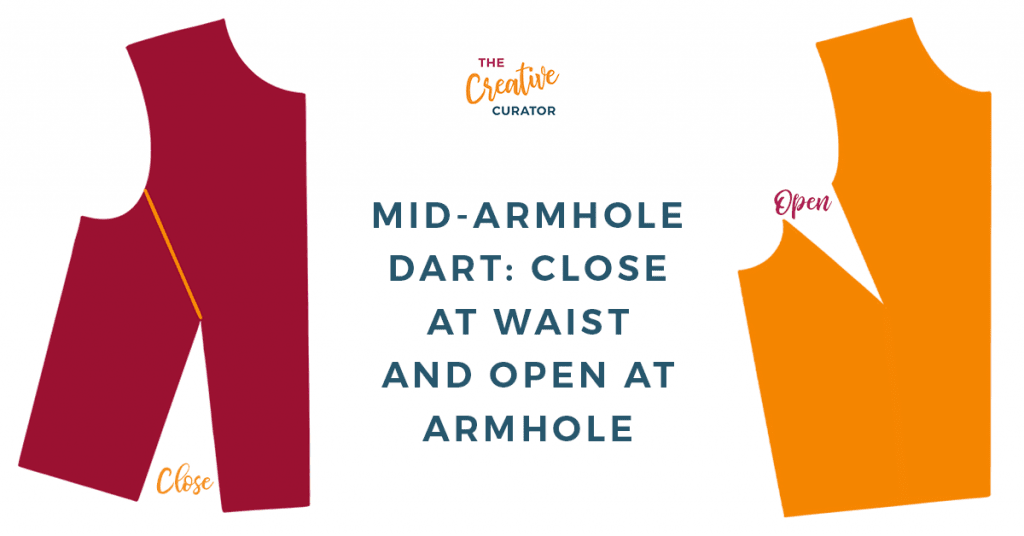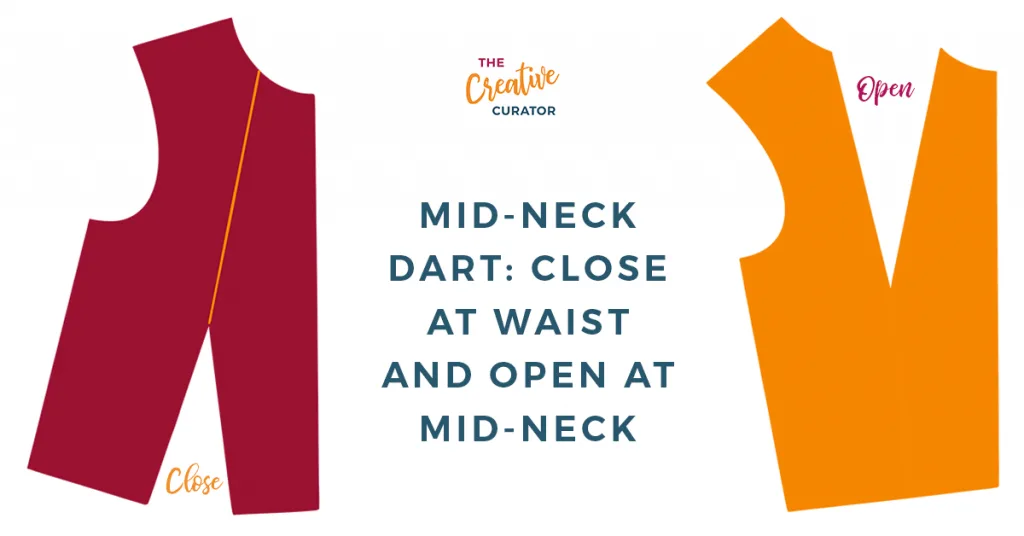This is the first in a series of articles and tutorials regarding the different types of darts and the process of dart manipulation. In this post you will learn what dart manipulation is, the two ways darts can be manipulated and the locations of those new darts.
Manipulating darts is one of the most creative ways to develop sewing patterns, or even get creative with patterns that you know and love.
The female body is made up of nooks and crannies, and to create clothes that fit those nooks and crannies, we need to manipulate the fabric to be more form fitting.
We use darts in sewing to suppress the fabric when we want to achieve this more fitted look.
However, as well as creating a more fitted appearance, darts also work to add fullness too, which helps to create interesting clothing styles.
In fact, understanding how dart manipulation works is essential when learning to drape on the dress form which is why there’s an entire module dedicated to it in my online course Drape & Contour for Beginners.

What Is Dart Manipulation?
Aha, now this is where we start getting into the nitty gritty of dart manipulation.
Dart manipulation is the art of taking the existing darts in a sewing pattern, and manipulating them around the pattern to achieve something else. It’s a common technique used in pattern making.
The actual dart manipulation definition reads (on Wikipedia):
“Darts are folds and are sewn into fabric to take in ease and provide shape to a garment.”
Now, that isn’t a very understandable definition of dart manipulation, so let’s break it down a little more.
If you imagine standing in front of a mirror, inside a tube of fabric. The fabric fits perfectly at the fuller areas – the hips and bust – but is baggy in other areas, such as the waist, around the chest, and below the hipline.
We need to compress that fabric so that it fits closer to the body, and we do that by using darts.
The manipulation of darts is most fun and creative around the women’s bust area.
We often go for a tailored look, with well fitted garments, or sometimes rather fun and playful styles with cool style-lines or added fullness created by dart manipulation.
What Is Added Fullness?
Added fullness is the result of manipulating darts to allow more fabric in an area of the sewing pattern, which results in more fullness.
A simple way to visualize it would be to think of a trapeze dress, which flares out with additional fullness.
This is done using dart manipulation.
Are There Types Of Dart Manipulation?
Yes! When it comes to manipulating darts there are two methods that are used:
- Slash and spread method
- Pivotal method
What Is The Slash and Spread Method In Pattern Making?
The slash and spread method in pattern making is exactly as it sounds.
Your pattern is cut (slashed) to the dart point, and then spread open the required amount to add fullness, or moved closer together to remove the fullness.
You can learn more about the slash and spread method here!
What Is The Pivot Method?
The pivot method of dart manipulation is when we move the pattern at the dart point, and trace around the pattern to remove or add fullness, instead of cutting into the pattern itself.
Slash And Spread Vs Pivot Method
Typically, any one new to pattern drafting and experimenting with dart manipulation would start by using the slash and spread method in pattern making.
It is an easier – though longer – process that works well and allows less room for error, as you are working directly with the existing pattern pieces.
Pivoting a pattern is a more advanced pattern drafting technique as there is more room for error. The number of times my awl has moved without my noticing, and I’ve ended up with something unexpected!
Which Dart Manipulation Technique Should I use?
If you’re new to dart manipulation, try the slash and spread first.
It’s fun, and I always find that when I have taught that technique to students in person, they grasp the concept of dart manipulation much faster.
I’m going to cover both in step by step tutorials further below, so don’t worry, you’ll have a chance to try both!
Types Of Darts In Sewing
There are only two types of darts in sewing:
- Single darts
- Double ended darts – also know as fisheye darts
Single Darts
Single darts are the ones which have one point, and two dart legs, forming a triangle of sorts.
These are found all over the bodice blocks, on the sleeve, trousers and skirts too. There isn’t anywhere that you cannot put a dart, depending on what the final effect is that you are aiming for.
Double Darts aka Fish Eye Darts
Double darts are also known as fisheye darts.
They have two endpoints, two wider points, and then legs that connect all points together. When seen un-sewn, they look like a fisheye.
The fish-eye dart is the dart you find on the front and back sections of a fitted dress pattern, running from the bust, down towards the hip, to suppress the fabric for a closer fitting dress.
What Are The Different Dart Styles?
Are there different dart styles? Yes!

There are 10 styles of dart on the basic front bodice. These are fixed locations that we would transfer a dart from and to:
- Standard waist dart
- French dart
- Armhole dart
- Mid shoulder dart
- Center front bust dart
- Center front neck dart
- Straight side seam dart
- Shoulder tip dart
- Mid neck dart
- Center front waist dart
Let’s take a look at each of these dart locations!
Standard Waist Dart Position
The standard waist dart is a vertical dart from the waistline up to the bust point.
It is one of the key darts used for manipulating fabric around the bodice.
The standard waist dart can be divided into two or three darts and sewn as darts, external pleats or tucks, for some style variations – we’ll cover that in a later tutorial!
French Dart Position

The French dart is a diagonal dart from the side seam up to the bust point.
It is created by transferring the excess in the waist dart into a dart at the lower side seam – usually 2-3 inches up from the waistline.
The French dart is often found on silk tops for a more ‘finished’ look.
Armhole Dart Position

The armhole dart is a diagonal dart from the mid armhole down towards the bust point.
This is quite a popular dart, used to shape tops and blouses around the bust that then fall straight down or into a flared hem.
Mid-Shoulder Dart Position

The mid-shoulder runs from the middle of your shoulder, down to the bust point.
You’ll often find this dart is drafted in when drafting a female bodice block.
Outside of drafting blocks, this dart is often incorporated into a princess style dress!
Center Front Bust Dart Position

The center front bust dart is a horizontal dart from the center front towards the bust point.
If the pattern is cut on the fold, this dart becomes a fish-eye dart, running horizontally.
This dart is often manipulated to create a little gathering on the center front rather than an actual dart.
It can also be used to create a bib or yoke effect on tops and dresses.
Center Front Neck Dart Position

The center front neck dart is a diagonal dart from the center front down to the bust point.
It is often used as part of a style-line to suppress the fabric in an interesting way.
Straight Side Seam Dart Position

A straight side seam is a horizontal dart from the side seam towards the bust point – the least used dart by me when I’m working on dart manipulation!
I also see it very rarely in current fashion, so might be one to steer clear of!
Shoulder Tip Dart Position

The shoulder tip dart is a more dramatic diagonal dart from the shoulder tip, running in and down, to the bust point.
Using a dart in this position is tricky, because you do end up with a very thin section of the bodice pattern next to the shoulder.
That said, if you were planning a bodice with the sleeve factored in – a kimono top or batwing top using the kimono sleeve patternmaking process – then the shoulder tip dart will work very well!
Mid-Neck Dart Position

A mid-neck dart – from the middle of the neck down to the bust point – is often used to open up the neckline and add fullness in the form of gathers around the neckline.
It can also be used to create front yokes and bibs on blouses or shirts.
Center Front Waist Dart Position

The center front waist dart is manipulated from the center waist to run diagonally from the waistline at center front, up to the bust point.
You can see from the various overview images above that in the examples, the dart is drawn as a straight line on the bodice outline.
As an actual dart however, the dart legs can be drawn straight or curved, depending on how much contouring is needed – we’ll cover contoured darts later on in this series.
Dart Manipulation Tutorials
Now that you have a thorough understanding of what dart manipulation is and the locations we move darts to, the next step is to actually start manipulating some darts.
Next week I’m going to show you how to use the two techniques for manipulating darts that we looked at earlier.
Slash And Spread Method
This is a great dart manipulation technique for beginners who want to try manipulating darts around the bust point.
Because you’re cutting the pattern, and physically moving paper around, it makes it easier to rasp the concept of dart manipulation.
Pivoting Darts
This technique is a little more advanced. There’s no cutting and moving of paper pattern pieces, instead we will be using an awl to manipulate the lower pattern and a pencil to trace off.
Dart Manipulation Techniques
Those dart manipulation tutorials are now live and you can follow along here:
If you’re ready to sew some darts, this tutorial on how to sew darts in a bodice!
In the meantime, if you have any thoughts or questions about dart manipulation, do drop them in the comments below!
And if you’re excited about dart manipulation, check out my online course Drape & Contour for Beginners, which will teach you how to manipulate darts around the bodice and skirt as well as draping bodice blocks, skirt blocks and more!


Victory
Tuesday 5th of March 2024
This really helped! Thank you
Goodnews
Saturday 29th of April 2023
I really enjoyed reading this and thank u for letting this out. U are amazing!
christy
Monday 14th of November 2022
I honestly appreciate this, and i would love to learn how to really manipulate a dart using the slash and spread method. thank you.
Christianah reuen
Friday 13th of August 2021
Thanks so much for this ma God bless you more with wisdom n understanding ma
Raviya Saifi
Sunday 30th of May 2021
Hello,
Eve Ma'am how are you ? Today i sighnup here and read your vlogs it's really helpful.
Thank you !
Eve Tokens
Monday 31st of May 2021
Hey Raviya! Lovely to see you here! If you'd like to see me add anything specific, do let me know! X